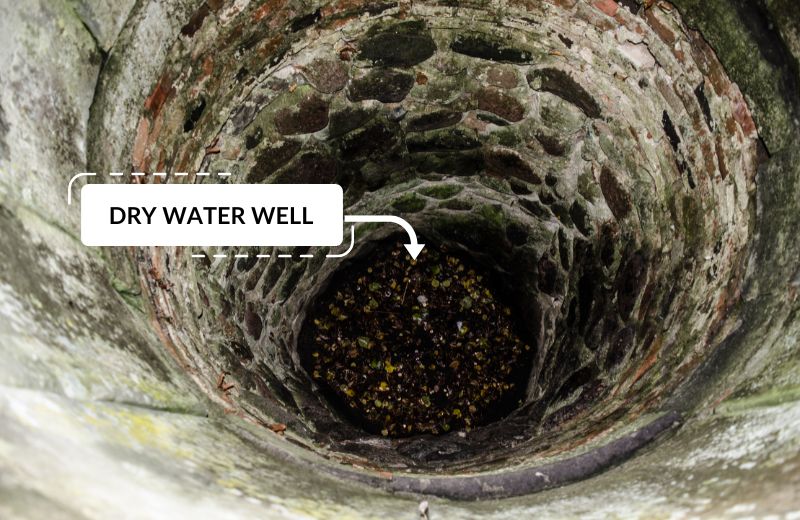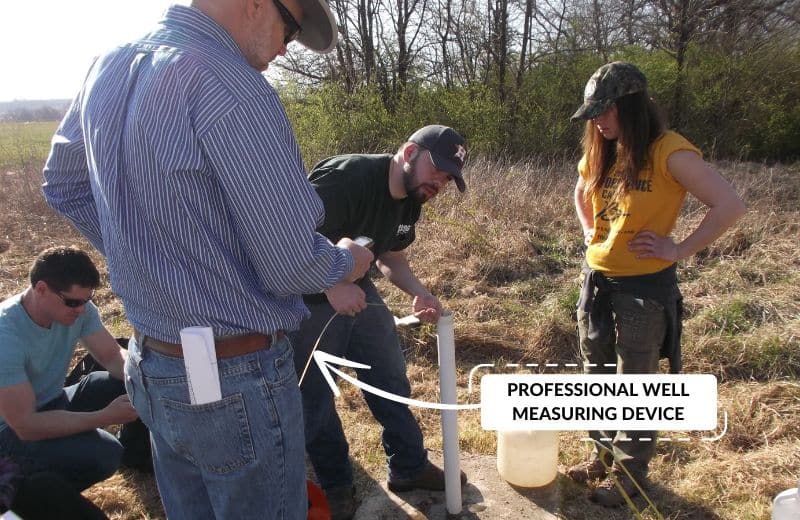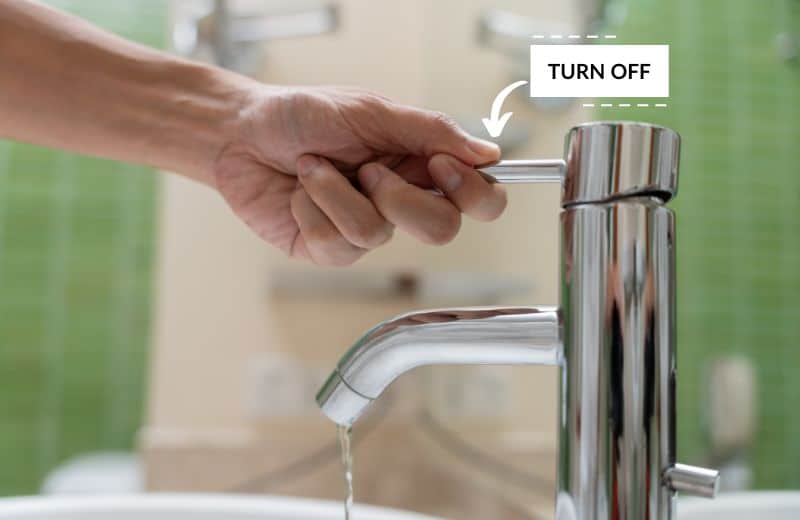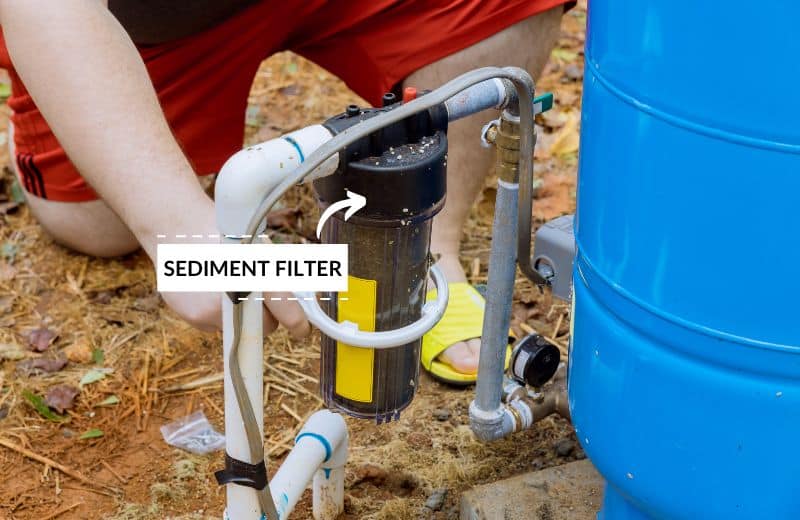A private well is an essential water resource during a drought. Wells provide a consistent supply of water, even during long, dry periods of drought, when surface water supplies may run low.
However, just because your private well is less susceptible to running dry in a drought, that doesn’t mean that it’s not at risk.
Here, we’ve shared our top tips on protecting your private well during drought conditions.
📌 Key Takeaways:
- A drought may cause groundwater levels to decline rapidly, possibly causing your well to dry out.
- You can protect your private well during a drought by taking steps to conserve your water at home, both indoors and outdoors.
- Monitor your groundwater levels to keep track of your well’s status and plan ahead for alternative ways to access water during a drought, such as harvesting rainwater or transporting water from a local water bulk station.
Table of Contents
🚱 How Do Droughts Impact Wells?
Drought conditions can affect the availability of groundwater, especially in shallow wells that are more susceptible to the changing seasons. It’s essential that you understand the possible effects of drought on your private well so that you can take appropriate measures to protect your water supply.
How Drought Affects Groundwater Levels
A drought is a period of low or no rainfall, which reduces soil moisture and groundwater levels.
In normal conditions, a private well has a recovery rate of around 5 gallons per minute. But if there’s very little water in the ground, the well will have little water to replenish with. This reduced water availability means that you’ll use water at a faster rate than the well can replenish its stocks. In a worst-case scenario, this could cause the well to dry out.
Shallow wells are particularly susceptible to running dry during long periods of drought because they’re closer to the surface of the earth.

How Drought Increases Contamination Issues
A private well isn’t at a higher risk of contamination during periods of drought, but there may be higher concentrations of contaminants present in a smaller volume of water.
As the water levels decrease, the contaminants present – including minerals, metals, and agricultural chemicals – will become more concentrated. The same contaminants are present, but in a reduced capacity of water.
Effects Of Drought On Private Wells
Some of the potential effects of drought on private wells include:
- Water scarcity: Your well may produce significantly reduced water volumes and may be at risk of drying out completely. You may have no choice but to reduce the water you use in your home during a drought.
- Water quality concerns: You may also notice changes to your well quality during a drought, including increased turbidity, high sediment levels, and changes in taste and odor.
- Regulations and restrictions: A side effect of a period of drought is that your local authority may issue water use regulations, including for groundwater use, that limit how much water you can draw from your well per day, or what you can use the water for.
📉 How To Monitor A Well During A Drought
There are three ways you can keep an eye on your well and groundwater usage during a drought:
Monitor Groundwater Levels
You can use a water level meter to monitor your groundwater levels, which will help you to monitor the water levels during a drought period and track trends week by week.
A water level meter consists of a stainless steel probe that’s attached to a flexible measuring tape, which, in turn, is wrapped around a hand reel that contains a switched circuit.
Water level meters measure the depth of water in wells, boreholes, and tanks. Simply lower the probe into the well until the display screen indicates that it has hit water. You can then read the depth to water by checking the number on the measuring tape.

Get Your Well Inspected
If you want an expert’s insight into your well water levels during a drought, arrange to get your well inspected.
Local well contractors should be familiar with your area’s normal groundwater levels, and can tell you whether or not your well’s groundwater levels are on the decline. They’ll also be able to advise you on whether you need to take action to conserve or protect your well water, and how best to do this.
You should get your well inspected once a year, drought or not, so your well contractor will be able to compare your groundwater reading to the last reading that was noted in your previous inspection.
Monitor Your Daily Water Usage
You might also want to monitor your water usage to get an idea of how much water you use for various purposes every day, and whether you can reduce your water usage during a period of drought.
The average family of four uses about 350 gallons of water per day. You can monitor your daily water usage with a smart meter, then work out whether your current water habits put your well at risk during a drought.
Simply being aware of your water usage will help you to use less because you’ll be more conscious of the potential effects of using too much water on your private well.
🛡️ How To Protect A Private Well During Drought
The best way to protect your private well during a drought is to conserve water (i.e. cut down on your water usage and be mindful of only using what you need).
Here are our top indoor and outdoor water conservation tips:
Indoor Water Conservation Tips
- Reduce your flushes – Only flush the toilet when absolutely necessary, and don’t use your toilet as a waste bin.
- Reuse your greywater – Save your greywater from showers, faucets, etc. for irrigation purposes, so you don’t have to use clean well water.
- Take shorter showers – Limit your showers to 2-3 minutes, or the length of one song.
- Fix leaks – Hunt out leaking faucets, shower heads, and pipes, and fix the leaks to prevent unnecessary water loss.
- Don’t leave the water running – When brushing your teeth and washing dishes, switch the faucet off or fill a bowl with water rather than letting the tap run.
- Buy water-conserving fixtures – Swap your faucets and shower heads to low-flow fixtures that reduce the water that flows through per minute.
- Educate your family members – Share your water conservation aims with other members of your family and ask them to help you to save water at home.

Outdoor Water Conservation Tips
- Water your lawn & plants by hand – Using an irrigation system may mean watering your outdoor spaces when you don’t need to, or overwatering, so water by hand instead.
- Wash your car with greywater – Reuse water from showers or washing dishes to wash your car, and avoid the hose pipe (this wastes gallons of unnecessary water!).
- Use a brush to clean your driveway – Avoid using a hose to clean your outdoor spaces, you can achieve similar results with a brush or a broom.
- Cover your pool – If you have a pool, cover it with a pool cover to reduce the water’s evaporation rate, minimizing the need for refills.
- Grow drought-resistant plants – Favor plants that don’t need a lot of water and are used to growing in warm, dry weather.
👨🔧 Learn more: 21 Easy Ways to Conserve Water at Home
Protecting Well Water Quality
It’s unlikely that your well water quality will change during a drought, but if your well supply runs low or dries out, you might see an increase in certain contaminants.
There are a few things you can do to protect your well water quality during a drought:
Test Your Water
Test your water for common well contaminants once a year. If you know of any groundwater pollutants in your area, also test your water for these according to your local authority’s advice.
If and when contaminants are detected, make sure to treat your water to remove them and keep your water safe to drink.

Keep An Eye Out For Quality Changes
If you notice any changes to the taste, appearance, or smell of your private well water during a drought, switch to bottled water and conduct a water test as soon as possible.
You may need to install additional treatment systems if your water contains a higher concentration of sediment, metals, or minerals as a result of a drought.
Avoid Potential Contamination Sources
If you’re using another water resource during a drought to reduce the strain on your private well (see below), treat the water to make it safe to drink (if it isn’t already) and be mindful of potential contamination sources.

📖 How To Manage Your Well Water Supply During A Drought
There are a few ways to prepare in advance for a drought and establish a water management plan that will help you to continue to access clean, safe water during a dry period.
Here are the best methods to manage your well water supply during a drought:
Establish Alternative Water Sources
If you’re worried about draining your well over a long, hot summer, establish an alternative water source that you can use on or near your property and take a percentage of your required water supply from this source.
For instance, you might also have access to a plentiful surface water source. While this may also be affected by drought, taking water from your well and another source will reduce the strain on both.
Harvest Rainwater
Harvesting rainwater is another great way to reduce the pressure on your well during a drought. You can install a water storage tank on your property and collect rainwater from a sloped roof, then store this water for emergency use in the summer.
We recommend a below-ground cistern, which will keep your water cool and is less susceptible to UV damage and freezing. You can pump the water to your home with a built-in pump or simply collect it for outdoor uses as and when you please.
If you plan to use collected rainwater for drinking, you’ll need to make sure the water is tested and treated to remove possible contaminants.

Access Community Resources & Organize Water Delivery
As a last resort, if you don’t have access to any other water sources on your property and you’re not connected to a municipal system, you can transport water from your local water bulk station to your home.
For this, you need a water tank for a trailer or a truck bed. Keep in mind that local water resources might be sparse during periods of drought, so it might make sense to stock up over the winter months in preparation for the upcoming summer season.
🔚 Final Word
Depleting your well supply isn’t ideal at the best of times – but it’s especially concerning during a drought. If you live in a rural region and you’re not on a city water supply, maintaining your well’s water stock is vital.
Thankfully, with some forethought, you can protect your private well during a drought and reduce the likelihood of the well drying out. Take steps to conserve your water, make sure to keep an eye on your well water quality, and consider other water supplies that you could tap into on your property.
